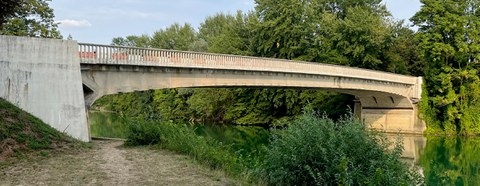Prestressed concrete between success and failure
Table of contents
Project data
| Titel | Title Erfolg und Misserfolg: Zum Beitrag erkannter Fehler für die Entwicklung der Spannbetonbauweise | Success and Failure: On the Contribution of Recognised Failures to the Development of Prestressed Concrete Construction Förderer | Funding Deutsche Forschungsgemeinschaft (DFG) / SPP 2255 Zeitraum | Period 10/2023 – 09/2026 Leiter | Project manager Prof. Dr.-Ing. Steffen Marx Bearbeiter | Contributor Dipl.-Ing. Jakob Vogt |
Report from annual report 2023
On the history of prestressed structures

Eugène Freyssinet's Pont du Lucanzy
The development of prestressed concrete construction has a significant impact on today’s construction methods and can be considered a success story. While the accomplishments of notable players like Finsterwalder and Freyssinet in the construction, e.g., of the Nibelungen Bridge and the Pont du Lucanzy are well known, there have also been demanding challenges and failures. However, in the technical history of prestressed concrete, these challenges and failures have not yet been fully explored. But an investigation of these failures can contribute to a better understanding of existing structures and help to preserve them.
The golden era of prestressed concrete construction dates back to the period between the 1930s and the 1980s, interrupted by the Second World War. In the pre-war period, knowledge of building materials in terms of creep, shrinkage and relaxation was discovered and deepened. After the war, numerous prestressed concrete structures were built, which led to an acceleration of development, especially in terms of bridge construction. After a while, crack damage appeared in those structures, and a variety of publications discussed the correct handling of, for example, thermal expansion, couplings, or deflection forces. New methods of construction and consequently, new areas of application were developed during this time period.
As part of the DFG Priority Program 2255 “Construction as cultural heritage”, this study aims to provide a detailed examination of the eventful high modern era. The result will be a critical history of prestressed concrete construction technology in terms of its successes and failures. The study analyzes bridge structures located in German-speaking countries, with a focus on the planning, construction, and fabrication processes. The research also examines the exchange of information about failures within the professional community and the development of standards. The investigation is carried out under constant consideration of the state of research and knowledge at the time and evaluates these from a current perspective. The overall question to be answered by the project is whether failed developments in prestressed concrete construction also represent a criterion for heritage status.
Summary
Prestressed concrete construction is associated with the high modern era like no other construction method. Its beginnings in the 1880s were initially primarily interesting engineering solutions to the problem of cracks in concrete. In the 20th century, prestressing became a disruptive innovation. It developed towards the most important construction method for filigree and wide-span concrete structures, despite several scientific and technical dead ends, misguided developments and cases of damage. The success story of prestressed concrete is sufficiently documented. However, an in-depth analysis of failures as innovation drivers is still pending.
In addition, the project refers to the initial core problem of SPP 2255: the increased demolition of civil engineering structures of the high modern era. Prestressed concrete structures are predestined to be overlooked, because their essential construction is invisible in the concrete and the valuable innovation often lies in structural details. An appropriate appreciation of prestressed concrete structures is therefore still a desideratum today. The main objective of the project is therefore to write a critically reflected construction history of prestressed concrete between success and failure as a basis for the heritage conservation of prestressed concrete buildings in Germany.
The manifold problems in the history of prestressed concrete, e.g. scientific misconceptions, insufficient theoretical penetration, difficulties on the building site, errors in detail, have so far often been marginalised. An essential part of the work is the identification, description and classification of failures and undesirable developments in the planning, design and construction process. Based on this, it will be explored how these mistakes have promoted and influenced the further development of the construction method. Another thesis is that disputes about "correct" procedures and "incorrect" assumptions have been arisen in the expert community especially with regard to concrete construction projects, which will be examined in depth. Furthermore, the question should be answered why, especially in the early phase, the actors involved adhered to prestressed concrete and pushed its further development despite sometimes considerable setbacks. Differences and their reasons between the state of the art regulated in standards and the current state of research as well as forms and limits of knowledge transfer across national borders will be worked out. Finally, interesting prestressed concrete buildings will be examined in terms of whether they are worthy of protection according to classical monument criteria or whether an expansion of the criteria is necessary.
The project focuses primarily on the development of prestressed concrete in Germany, especially in bridge construction. Influences from France, especially in the first half of the high modern era, and Switzerland in the second half are also taken into consideration.
